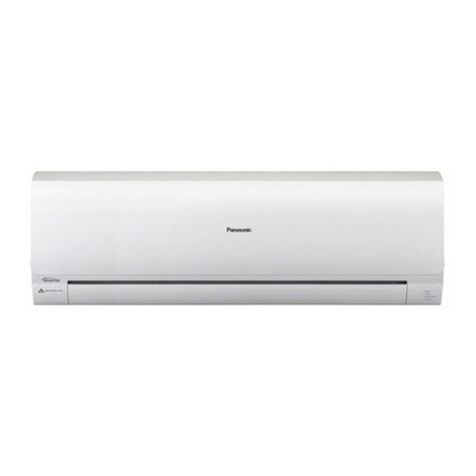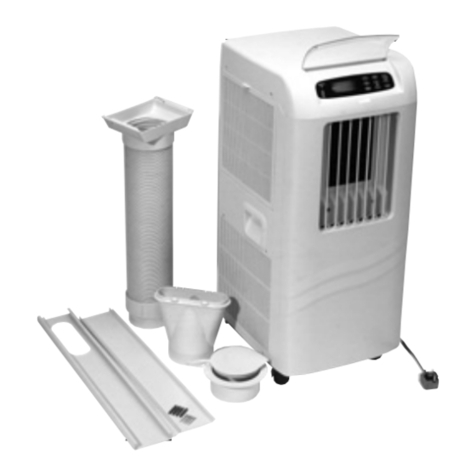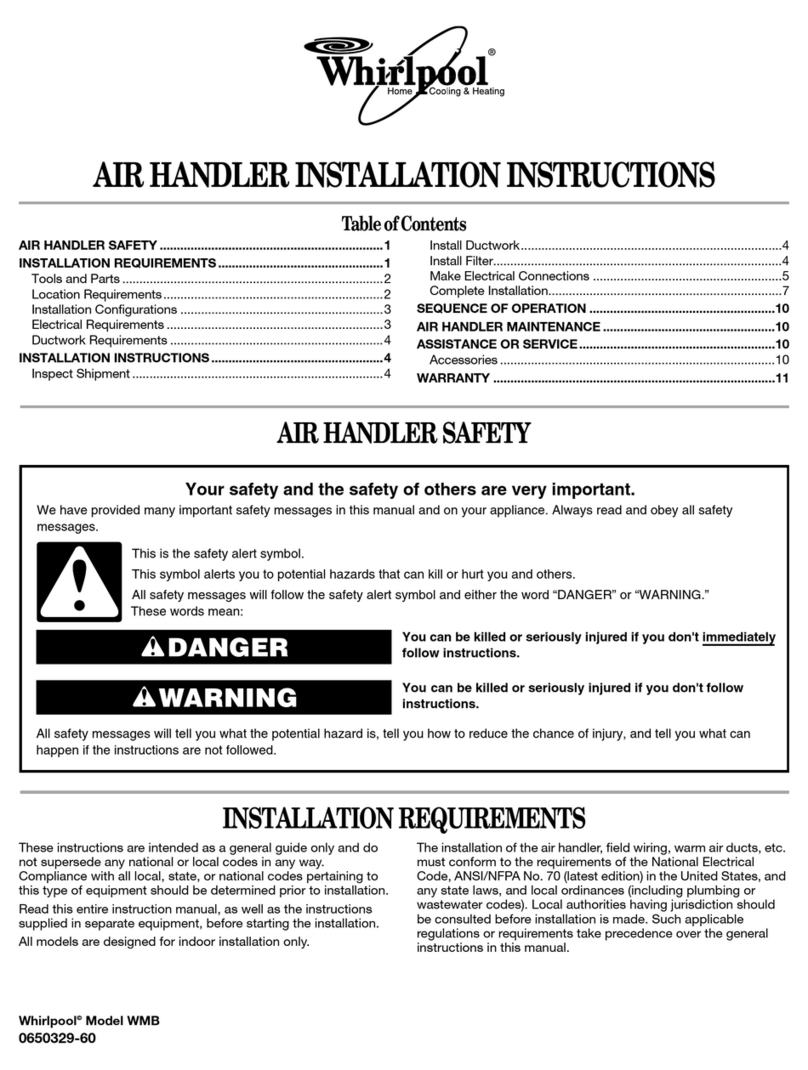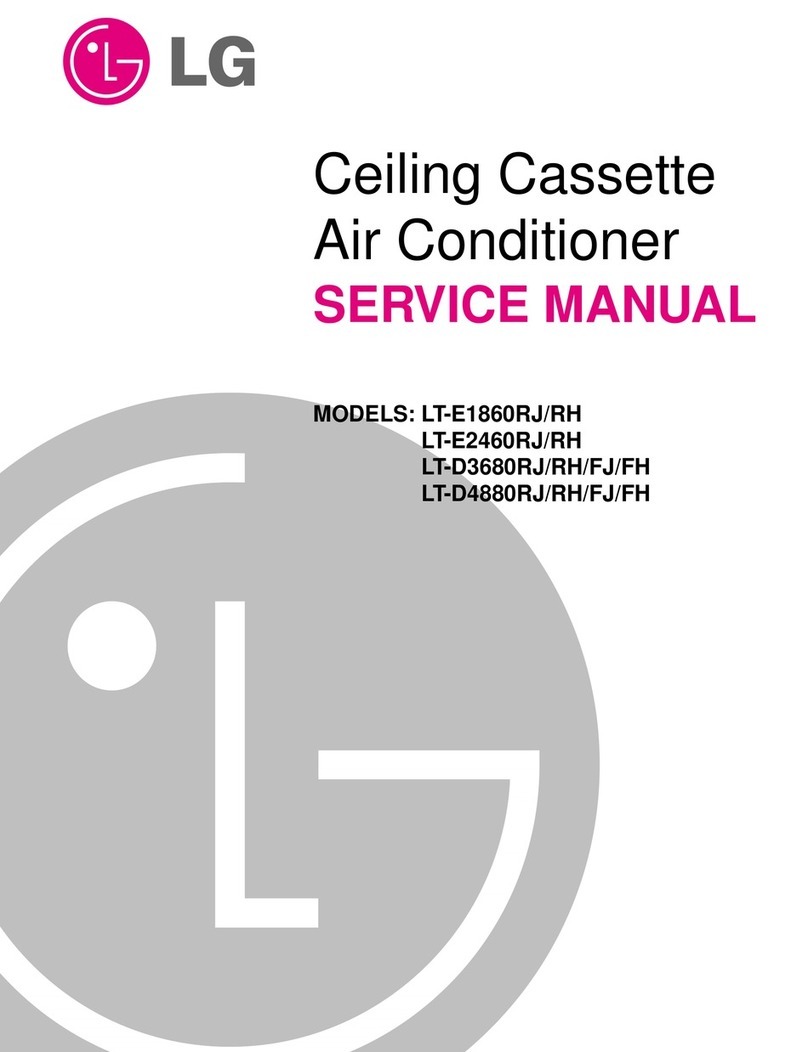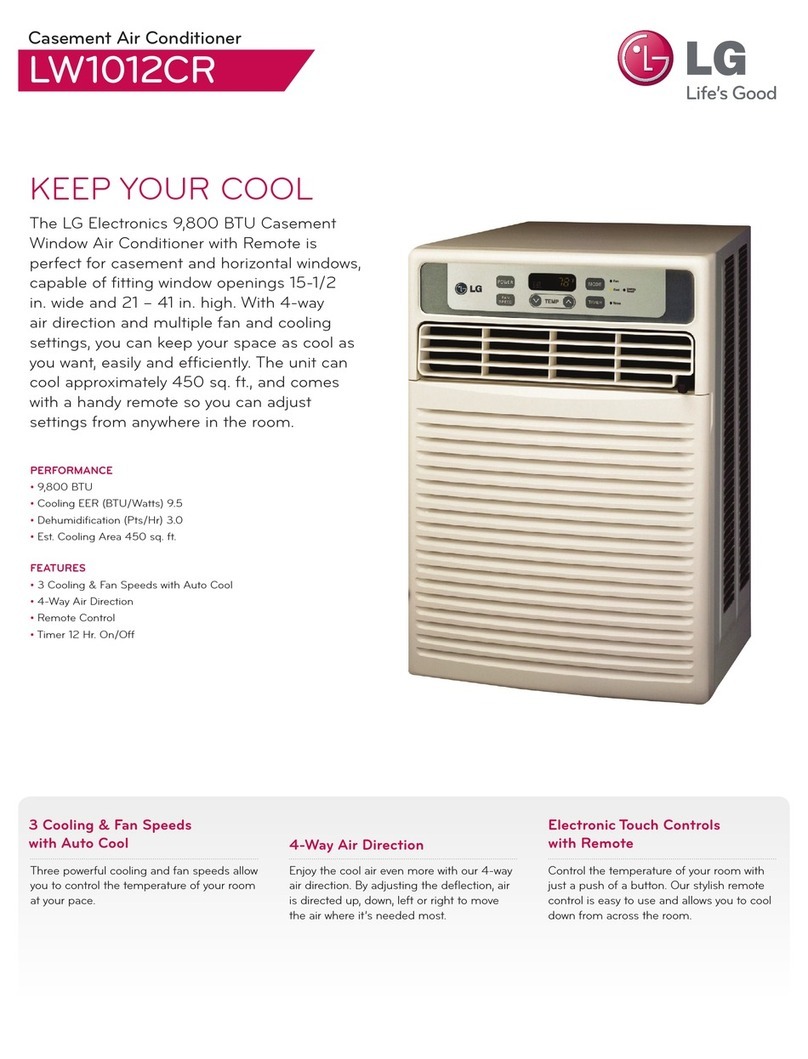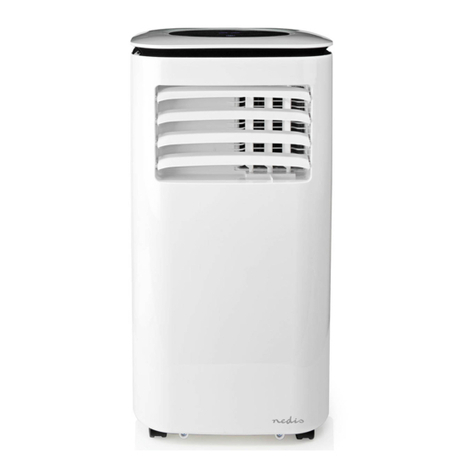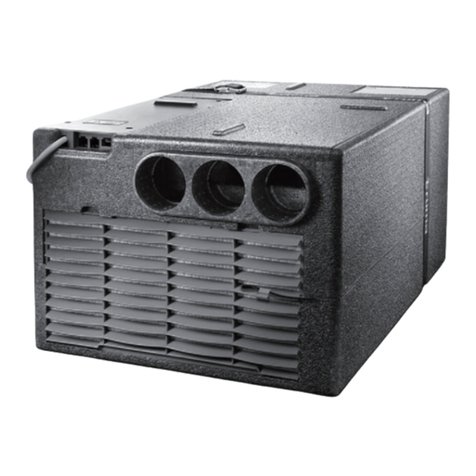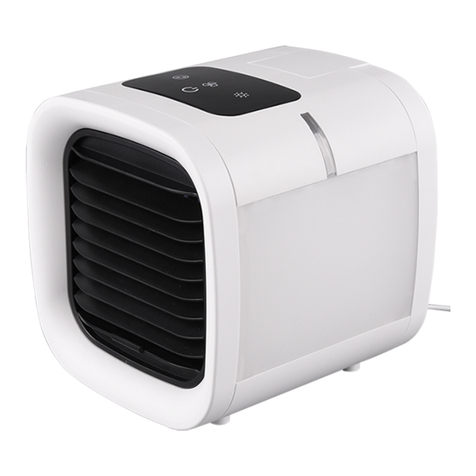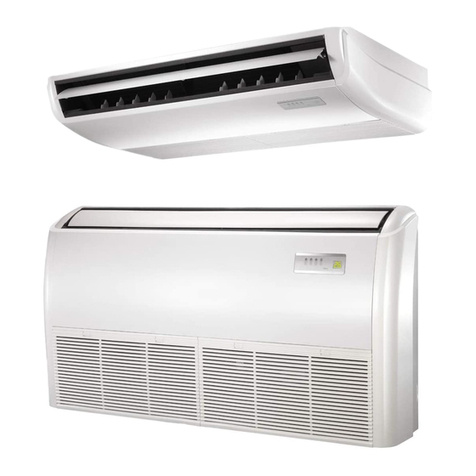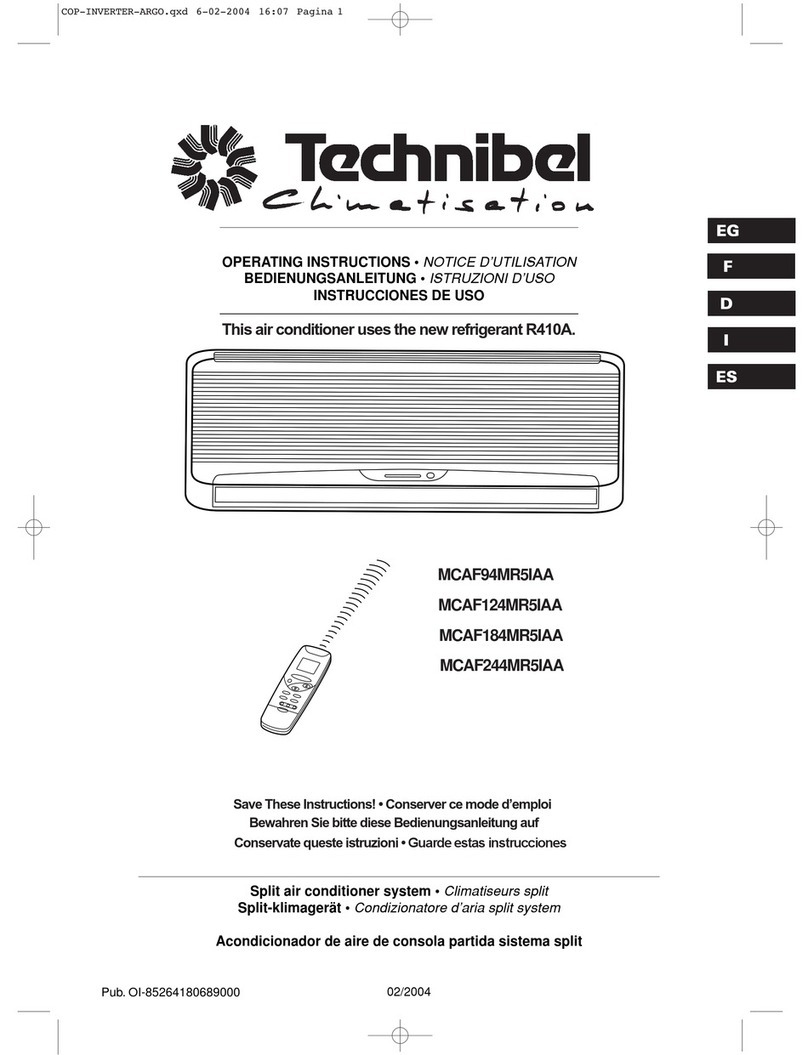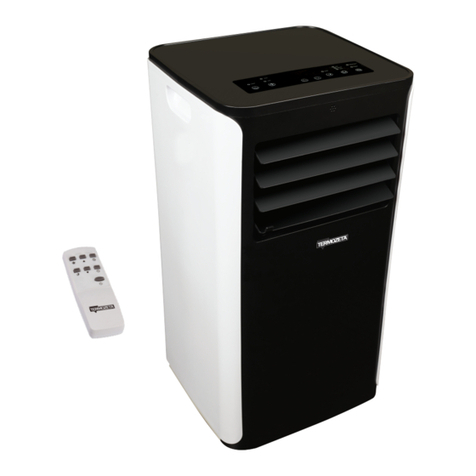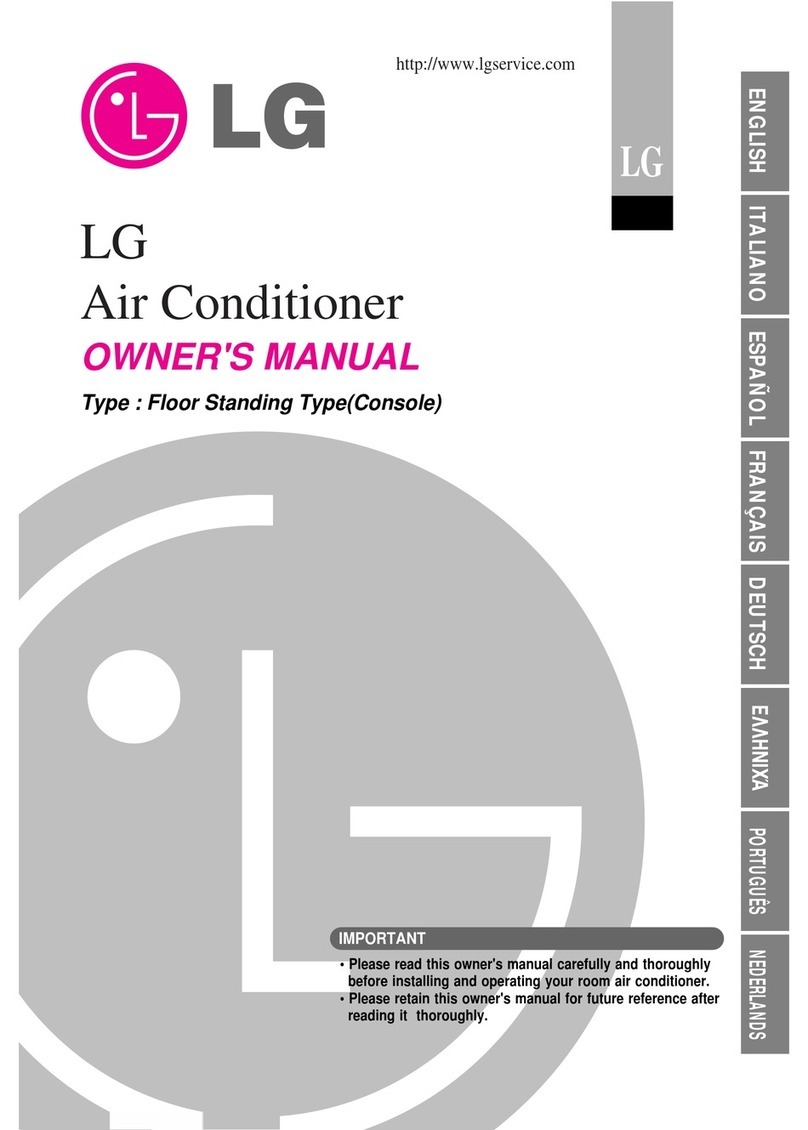Data Aire DAMA-01 User manual

MINI CEILING UNITS
Installation, Operation and
Maintenance Manual
Packaged Unit
Split System
Packa
g
ed Uni
t


3
Table of Contents
1.0 Installation
1.1 Room Considerations......................................................................................6
1.2 Inspection........................................................................................................6
1.3 Locating the unit..............................................................................................6
1.3.1 Vertical airflow units..............................................................................7
1.3.2 Air cooled packaged units.....................................................................7
1.3.3 Horizontal airflow units..........................................................................8
1.3.4 Indoor condensers and condensing units.............................................8
1.4 Paper work ......................................................................................................8
1.5 Storage............................................................................................................8
1.6 Model identification..........................................................................................9
2.0 Piping
2.1 Split air cooled unit piping..............................................................................10
2.1.1 Discharge lines...................................................................................10
2.1.2 Liquid lines..........................................................................................10
2.1.3 Suction lines........................................................................................11
2.1.4 Connection sizes, aif cooled units ......................................................11
2.1.5 Field piping - remote condenser.........................................................11
2.1.6 Field piping - remote condensing unit.................................................12
2.2 Water/glycol unit piping
2.2.1 Field piping - water/glycol system.......................................................12
2.2.2 Connection sizes - water/glycol system..............................................13
2.2.3 Connection sizes - fluid coolers (dry coolers).....................................13
2.3 Auxiliary chilled water coil piping...................................................................14
2.4 Condensate drain piing..................................................................................14
2.5 Humidifier piping............................................................................................14
2.6 Leak testing...................................................................................................14
2.7 Evacuation.....................................................................................................15
3.0 Electrical connections
3.1 Electrical service............................................................................................16
3.2 Nameplate rating...........................................................................................16
3.3 Grounding......................................................................................................16
3.4 Voltage tolerance...........................................................................................16
3.5 Auxiliary control wiring...................................................................................16
3.6 Remote shutdown..........................................................................................17
3.7 Remote alarm contacts..................................................................................17
3.7.1 Mini DAP II units.................................................................................17
3.7.2 Mini DAP III units................................................................................17
3.8 Remote sensors ............................................................................................17
3.8.1 Mini DAP II units.................................................................................17
3.8.2 Mini DAP III units................................................................................18
3.9 Condensate pumps .......................................................................................18

4
4.0 Installation of remote outdoor heat exchanger
4.1 Rigging ..........................................................................................................19
4.2 Leg assembly ................................................................................................19
4.3 Locating the remote heat exchanger.............................................................19
4.4 Electrical Service...........................................................................................20
4.5 Air cooled condensers - Model DARC...........................................................20
4.5.1 Fan speed control...............................................................................20
4.6 Fluid coolers - model DAFC ..........................................................................20
4.6.1 Fluid-sensing thermostats...................................................................20
4.6.2 Energy saver cooling...........................................................................21
5.0 Charging
5.1 Voltage phase check .....................................................................................22
5.1.1 Evaporator..........................................................................................22
5.1.2 Secondary heat exchanger.................................................................22
5.2 Air cooled systems ........................................................................................22
5.2.1 Package air cooled systems...............................................................22
5.2.2 Split indoor air cooled systems charging - indoor condenser.............23
5.2.3 Fan speed control system charging - outdoor condenser ..................24
5.2.4 Flooded system charging....................................................................25
5.3 Water/glycol cooled systems.........................................................................26
5.3.1 Water/glycol cooled system charging .................................................26
5.3.2 Factor charge for water/glycol cooled systems...................................26
5.4 Refrigerant handling......................................................................................27
5.5 Important refrigeration components...............................................................27
5.5.1 Expansion valve..................................................................................27
5.5.2 High pressure cut out switch...............................................................27
5.5.3 Low pressure cut out switch ...............................................................27
6.0 Glycol Systems
6.1 Glycol concentrations....................................................................................28
6.2 Internal (fluid) volume....................................................................................28
6.3 Fluid cooler internal volume...........................................................................28
6.4 Copper piping internal volume.......................................................................28
6.5 Freezing point or aqueous solutions..............................................................29
7.0 Controls
7.1 Standard thermostat......................................................................................30
7.2 Optional programmable thermostat...............................................................30
7.3 Optional Mini DAP II microprocessor control panel.......................................30
7.4 Optional Mini DAP III microprocessor control panel......................................30
7.5 Optional DAP III.............................................................................................30
7.6 Wiring diagrams.............................................................................................31
8.0 Regular maintenance items...................................................................................32
8.1 Air filters.........................................................................................................32
8.2 Belts ...........................................................................................................32
8.3 Bearings ........................................................................................................32

5
8.4 Humidifier canisters.......................................................................................33
8.5 Fuses ...........................................................................................................33
8.6 Heating elements...........................................................................................33
8.7 Refrigerant filter drier.....................................................................................33
9.0 Warranty policy......................................................................................................34
10.0 Contact Data Aire..................................................................................................35
11.0 Reference
Recommended line sizing for air cooled split systems..................................36
Temperature-pressure chart ..........................................................................37
Superheat and Suction Pressure Trouble Shooting Guide............................38
Maintenance/Inspection Check List...................................................................

6
1.0 INSTALLATION
WARNING: There is no intent on the part of Data Aire, Inc. to define local codes and
statutes which may supersede common trade practices. The manufacturer assumes
no responsibility for their interpretation. Consult local building codes and the National
Electrical Code for special installation requirements.
1.1 Room Considerations
Precision air conditioning equipment is designed to control spaces within close tolerances of tem-
perature and humidity. However, the room must be built with a proper vapor barrier. A film of poly-
ethylene is often used on walls and ceilings. Floors must be painted with vapor seal paint. All doors
to the controlled space should be equipped with weather seals to prevent the infiltration of non-
neutral conditioned air from entering the space. Failure to provide a vapor barrier can compromise
the ability to control space conditions.
Introduction of outside air into the controlled space should be minimized. Outside air in excess of
5% of the total circulated air volume can have a significant effect on the overall space conditions and
result in poor space control. All outside air that is introduced should be conditioned to the humidity
and temperature parameters of the computer room air conditioned (CRAC) unit setpoints to main-
tain the room’s design conditions.
1.2 Inspection
This equipment has been factory run-tested and has gone through a comprehensive inspection pri-
or to its packaging and shipment to ensure that it arrives in excellent condition. However, shipping
damage can occur and a visual inspection of the outer crating immediately upon delivery should be
performed.
Note any external damage or other transportation damage on the freight carrier’s forms. Inspect the
unit itself for internal damage. A claim should be filed with the shipping company if the equipment
is damaged or incomplete.
Loose items such as remote control panel, disconnect switch handle and spare belts are packed
inside the unit. Refer to the yellow shipping tag located on the electrical section panel.
WARNING: Freight damage claims are the responsibility of the purchaser. Action to
recover losses should be filed immediately. Please notify Data Aire of any claims.
1.3 Locating the Unit
The unit is intended for above the ceiling installation and is typically suspended from structural
members in the building above the ceiling. Add a 50% safety factor to the weight of the unit to de-
termine the strength of the supporting structural members.
Appropriate service access above the ceiling is required around all service and electrical access
panels. There must unobstructed clearance below the unit allowing ladder access to enable routine
maintenance and service.

7
NOTE: There are many available unit configurations for Mini Ceiling systems. Be sure to
identify the unit type and style before installing. There may be split condenser and con-
densing units that require separate or shared power.
NOTE: Condensation formation and frequent humidifier flushing (units with humidifi-
er) are normal functions of this equipment. Drain connections must be made to ensure
proper water removal. Unit will require drain connections for condensate removal and
water connections for humidifier make-up water, chilled water and/or hot water. Instal-
lation above equipment that could sustain water damage should be avoided.
1.3.1 Vertical Airflow Units
The evaporator section is typically mounted over a standard 2’ x 4’ T-bar ceiling grid supported by
four threaded rods. The four threaded rods must be securely attached to the building structure.
Raise the evaporator section with an appropriate lifting device. Attach washers, nuts and nut jams
to each threaded rod. Tighten the nuts so the weight is supported evenly. Be sure the unit is level.
Allow for the depth (5”) of the supply/return air plenum when figuring the height of the unit above
the ceiling.
The 5” tall vertical supply/return plenum assembly is attached to the bottom of the evaporator sec-
tion once the evaporator section is installed. Six screws fasten the plenum to the evaporator sec-
tion. The supply/return air grilles should be temporarily removed for access during installation. The
plenum typically mounts flush to the ceiling grid (depending on available space above unit).
1.3.2 Air Cooled Packaged Units
Air cooled package units require an additional condenser fan section to be mounted to the end of
evaporator section at the condenser coil. Place a gasket around the perimeter of the condenser
coil opening. Connect the female motor plug from the condenser blower section to the male plug
inside the evaporator section. Attach the condenser blower section using four (4) self-drilling # 10
sheet metal screws.

8
1.3.3 Horizontal Airflow Units
Ductwork is connected to factory provided duct collars on the supply and return air openings.
Four threaded support rods must be securely attached to the building structure. Raise the evapora-
tor section with an appropriate lifting device. Attach washers, nuts and jam nuts to each threaded
rod. Tighten the nut so the weight is supported evenly by the four rods and the unit is level.
NOTE: Some options call for a combination of vertical and horizontal airflow configurations.
In these cases a 5” plenum assembly as previously described is required.
1.3.4 Indoor Condensers and Condensing Units
Air cooled units are available with either an indoor condenser section or an indoor condensing unit
(units are also available with remote outdoor condenser or condensing units – outdoor sections
have their own installation, operation and maintenance manuals). Air cooled condensers and con-
densing units have factory provided duct collars on the supply and intake air openings (split water
cooling condensing units do not have airflow connections).
Four threaded support rods must be securely attached to the building structure. Raise the evapora-
tor section with an appropriate lifting device. Attach washers, nuts and nut jams to each threaded
rod. Tighten the nut so the weight is supported evenly by the four rods and the unit is level.
Typical installations have the indoor condenser or indoor condensing unit near or adjacent to the
evaporator section especially when shared electrical power is required. The same service and
maintenance requirements apply to these units as well.
1.4 Paperwork
Each Data Aire unit ships with start-up sheets that must completed. The start-up sheets are en-
closed in packet with the unit. The packet includes the warranty certificate, wiring diagrams, specific
component literature, warranty registration card and a copy of the unit’s Installation/Operation and
Maintenance manual.
A manila tag is attached to the outside panel to indicate articles that have been packaged and
shipped loose within the unit cabinet.
NOTE: It is the responsibility of the start-up service company to return the start-up sheets
and warranty registration card to Data Aire for activation of the unit warranty. Failure to
do so may cause delays in warranty related services and in some cases void the warranty.
1.5 Storage
Your Data Aire equipment comes ready for immediate installation. In some instances it may be
necessary to store the equipment for a period of time. If you must store the equipment it should
be done in a dry area, out of the weather, protected from damage by other equipment in storage or
transportation equipment, never stacked and avoid frequent relocation.

9
If equipment is stored for longer than 30 days special precautions must be taken to avoid coil dam-
age. All coils should be charged and sealed with a low pressure (less the 25 PSIG) inert gas, such
nitrogen. This prevents contaminants from entering the coils. When the seal is broken at installa-
tion, the rush of escaping gas verifies the coil is still leak free. If coils are not charged and sealed,
condensation mixes with air pollutants forming a weak acid and over time can cause pinhole leaks
to develop in coil tubes.
When equipment is installed after storage, caution should be taken to inspect and replace, if re-
quired, rubber hoses and belts. All moving parts, such as blowers and motors, should be hand
tested to ensure they are free and clear prior to start-up. Finally, verify that all lubrication is fresh
and full.
1.6 Model Identification

10
2.0 PIPING
2.1 Split Air Cooled Unit Piping
Refer to the attached line sizing chart on page 36 for a guideline for sizing refrigerant lines. The ulti-
mate responsibility for line sizing selection is that of the installing contractor or the project engineer.
DataAire does not assume this responsibility. The chart covers distances up to 200 equivalent feet.
For installations greater than this distance, consult ASHRAE or similar references.
Standard piping practices must be used to ensure proper oil return and efficient operation. The
interconnecting lines to the remote air cooled condenser or condensing unit must be installed by
a qualified refrigeration mechanic.
2.1.1 Discharge Lines
Discharge lines, also called hot gas lines, should be trapped at the top (inverted) and bottom, as
well as every 15 to 20 feet of vertical rise. Discharge line check valves are recommended on all
installations, especially those where there are long pipe runs or cold climate. Check valves should
be installed no less than 6 feet from the compressor. The discharge, suction and liquid lines need
to be refrigerant grade copper and in accordance with local code. All refrigeration piping should be
installed with high temperature brazed joints. When brazing, a supply of nitrogen gas needs to be
fed through the refrigerant lines. Be sure to open the other end of the refrigerant line to allow the
nitrogen to bleed off and not pressurize the piping. Prevailing good refrigeration practices should
be employed for piping support, leak testing, dehydration and charging of the refrigerant circuits.
During the installation the lines should be capped off and filled with dry nitrogen at the end of each
day’s work or until the system is completed and sealed.
Data Aire recommends a silver/phosphorus/copper alloy with 5 to 15% silver to be used to braze
the refrigerant line sets to the indoor and outdoor units. Nitrogen needs to be flowing through the
lines to eliminate carbon deposit build-up of the joints. Carbon could contaminate the refrigerant
and restrict the metering device.
Piping must be supported within 18” of the inlet and outlet connections. The inlet connection is
located on the top header of all units. The discharge outlet is located at the bottom of the header.
The discharge line pressure drop should not exceed 6 PSIG for R-407C and 9 PSIG for R-410A.
Recommended gas velocity for proper oil return is 1,000 FPM. Slope horizontal lines downward in
the direction of refrigerant flow, 1/2” for every 10 feet of line length. Discharge lines do not require
insulation but due to the high temperatures of the refrigerant inside the line, the pipes may be insu-
lated to protect against burns to individuals near or around the lines.
2.1.2 Liquid Lines
Liquid lines are determined by pressure drop and velocity. The liquid line pressure drop for R-407C
should not exceed 5 PSIG. For systems with R-410A, the pressure drop should not exceed 9
PSIG. The recommended velocity should be between 200 and 300 FPM. To avoid excessive liquid
line pressure drop, the air cooled condenser should be located above or at the same level as the

11
evaporator. Condenser installations more than 10 feet below the evaporator are not recommended.
Insulation of liquid lines is not required but can be useful in preventing condensation from forming
and to avoid flashing on long pipe runs.
2.1.3 Suction Lines
Some applications call for the compressor to be mounted as part of the condenser, more commonly
referred to as a condensing unit. Such require field piping of liquid and suction lines. Suction lines
are trapped similarly to discharge lines. Common practice for suction line selection and installation
should be followed. Suction lines should always be insulated.
2.1.4 Connection Sizes, Air Cooled Units
MODEL HOT GAS LINE LIQUID LINE SUCTION LINE
DAMA-01 1/2” 1/2” 3/4”
DAMA-1.5 1/2” 1/2” 3/4”
DAMA-02 1/2” 1/2” 3/4”
DAMA-2.5 1/2” 1/2” 3/4”
Note: Units will have a liquid line and either a hot gas or suction line
Field connections at the indoor evaporator and remote condenser or condensing unit will
not necessarily be the same as the field pipe size required. In some cases these sizes will
vary significantly.
2.1.5 Field Piping, Remote Condenser

12
2.1.6 Field Piping, Remote Condensing Unit
2.2 Water/Glycol Unit Piping
The required field installed condenser water pipe sizes may or may not be the same as the connec-
tion sizes at the evaporator section or fluid cooler (refer to Sections 2.2.2 and 2.2.3 for connection
sizes). Water pipe sizes will depend on the length of pipe required and the calculated pressure drop
of peripheral components.
Water cooled units may also be connected to building water or tower water sources. Pipe size will
depend on length of run and the maximum water flow required.
All water/glycol units are shipped with plate/fin heat exchangers as standard equipment. A strainer
is shipped loose and is to be field installed in the supply line with shut-off valves (field provided)
before and after the strainer. The strainers and water/glycol piping must be cleaned on a periodic
basis. If the unit is shipped with optional shell and tube condenser, strainers are not required nor
shipped with the unit.
All water pipes have a cap installed on the end of the pipe for pressure testing the system. These
caps need to be removed before installing the water piping to the unit. Use a tube cutter for smaller
pipes and a reciprocating saw with a metal cutting blade for larger pipe sizes or if there is a clear-
ance problem. All connections need to be cleaned before connections are brazed together.
NOTE: One of the most common problems in a water/glycol system is the presence of air
in the condenser loop. Air vents must be installed in various locations in the piping system
to purge the air.
Water/glycol system piping may include a centrifugal pump (or pumps for redundancy). Pumps
must be primed before operating per the pump manufacturer’s guidelines.

13
2.2.2 Field Piping, Water/Glycol System
2.2.3 Connection Sizes, Water/Glycol Cooled Units
EVAPORATOR
MODEL WATER IN
CONNECTION WATER OUT
CONNECTION
DAMW/G-01 3/4” O.D. 3/4” O.D.
DAMW/G-1.5 3/4” O.D. 3/4” O.D.
DAMW/G-02 3/4” O.D. 3/4” O.D.
DAMW/G-2.5 3/4” O.D. 3/4” O.D.
2.2.3 Connection Sizes, Fluid Coolers (Dry Coolers)
EVAPORATOR
MODEL WATER IN
CONNECTION WATER OUT
CONNECTION
DAFC-06 1-5/8” O.D. 1-5/8” O.D.
DAFC-07 1-5/8” O.D. 1-5/8” O.D.
DAFC-09 1-5/8” O.D. 1-5/8” O.D.
DAFC-11 2-1/8” O.D. 2-1/8” O.D.
DAFC-15 2-1/8” O.D. 2-1/8” O.D.
DAFC-17 2-5/8” O.D. 2-5/8” O.D.

14
2.3 Auxiliary Chilled Water Coil Piping
Units with an optionalAuxiliary Chilled Water cooling coil require a separate source of chilled water.
The chilled water connection sizes will be the same as those listed for the condenser water (see
chart in Section 2.2.3). Units with optional Energy Saver coil typically have shared or common pip-
ing with the condenser supply and therefore do not require a separate cooling source.
All water pipes have a cap installed on the end of the pipe for pressure testing the system. These
caps need to be removed before installing the water piping to the unit. Use a tube cutter for smaller
pipes and a reciprocating saw with a metal cutting blade for larger pipe sizes or if there is a clear-
ance problem. All connections need to be cleaned before connections are brazed together.
2.4 Condensate Drain Piping
The evaporator section is provided with a 3/4” FPT connection on the bottom for condensate re-
moval. Units with vertical air discharge have the 5” plenum below the evaporator drain pan with
knockouts that allow field supplied ad installed condensate lines to be routed out either side. A
union is recommended at the field connection which will permit easy disconnection from the unit for
cleaning.
A trap should be built into the drain line to prevent air from backing up into the unit. Drain lines
should be pitched downward not less than 1/4” for each 10 feet of horizontal run. Do not reduce the
size of the drain line. Where local codes permit, PVC pipe may be used.
Some applications or installations have no convenient means of allowing a gravity drain. In this
case a condensate pump can be used. An optional condensate pump can be factory mounted and
wired or shipped loose for field installation. Factory mounted pumps do not require a separate
power source.
Optional condensate that are shipped loose (or field provided) typically require a dedicated 110 volt
power source. Field pipe connections must be made to the pump discharge connection. A check
valve must be installed to prevent short cycling.
2.5 Humidifier Piping
The optional humidifier on Mini Ceiling systems is a steam generator type with disposable cylinder.
The humidifier make-up water should be brought to the humidifier through the field connection open-
ing using 1/4” copper tubing. A compression fitting is provided at the humidifier. A shut-off valve
should be provided outside the unit to allow disconnection of service. An in-line water pressure
regulator and strainer should be installed. Water pressure should be set between 30 and 80 PSI.
The humidifier has a drain at the bottom which is factory piped to the main condensate drain line.
The dispersion tube also has a drain line. No additional field piping is required.
2.6 Leak Testing
No installation is complete until the entire system has been thoroughly checked for leaks. This in-
cludes checking refrigerant tubing, flare fittings, pressure controls, shraeder fittings and compressor
rotolock service valves. Check both field and factory connections.

15
In addition to the refrigeration system, check all condenser water lines, humidifier make-up lines,
condensate lines, condensate pumps, chilled water lines, centrifugal pumps and fluid coolers as
applicable.
When handling or recovering refrigerant it is not permissible to release refrigerant into the atmo-
sphere. Many leak-test methods recommended in the past are no longer possible. Current stan-
dard practices must be used.
Pressurize system circuit to 150 PSIG (1034 kPa) by using dry nitrogen with a trace of refrigerant.
Check the entire system for leaks with suitable leak finder (per local code) including but limited to
all braze joints, caps, fittings and flare nuts on both field and factory furnished components. After
completion of leak testing, release test pressure and pull a vacuum on the system.
NOTE: Tightening of fittings and valves is the responsibility of the installing contractor
2.7 Evacuation
Evacuate the refrigerant lines, condenser coil and evaporator coil to 250 microns or lower (a micron
gauge and 2-stage vacuum pump are required). Valve off and turn off the vacuum pump and wait
for at least fifteen minutes to make sure the micron gauge reading does not go back up above 700
microns. If it does, re-start the vacuum pump and evacuate until the system reaches 250 microns.
If the system still does not hold the pressure below 700 microns the system needs to be rechecked
for leaks.
After the system has been satisfactorily evacuated the unit(s) can be charged with refrigerant. Con-
nect the pressure gauge manifold set to the high and low ports near the compressor, connect the
charging line to the refrigerant tank and set it for liquid feed. Open the refrigerant tank valve and
purge the line at the manifold, then open the high side valve on the manifold only, and allow the
refrigerant to flow until the system pressure equalizes. At this point the system will have 75 to 80%
of the total refrigerant charge. Start the blower and then the compressor checking the operating
pressure and temperatures.
WARNING: DO NOT APPLY POWER TO THE COMPRESSOR WHEN IN A VACUUM

16
3.0 ELECTRICAL CONNECTIONS
WARNING: Before proceeding with electrical connections, make certain that
the volts, hertz and phase correspond to that specified on the unit electrical
nameplate. Use copper conductors only
3.1 Electrical Service
Check to be sure the service provided by the utility is sufficient to handle the additional load imposed
by this equipment. Units with secondary heat exchangers will require a separate power source and
field provided interconnecting control wires as well. Indoor split units typically have a single power
source but can also be provided with separate sources. Field provided interconnecting control wires
are also required. See Section 3.5 (Auxiliary Control Wiring).
Remote outdoor condensers and condensing units require one power source. Glycol system with
fluid coolers and loose pump(s) typically require one power source for the fluid cooler and will re-
quire one additional source for a single pump or two additional sources for dual pumps. Systems
where the pumps are mounted and piped integral to the fluid cooler will usually require a single
power source.
3.2 Nameplate Ratings
Refer to the unit nameplate for equipment electrical requirements. Minimum Circuit Ampacity
(MCA), also known as wire sizing amps, will dictate the minimum required wire gauge. Maximum
Overcurrent Protection (MOP) Device amps will dictate circuit breaker or fuse size.
3.3 Grounding
The unit cabinet must have an uninterrupted true earth ground. An electrical ground wire of ad-
equate size must be connected to the ground lug provided inside the main electrical box.
3.4 Voltage Tolerance
The supply voltage to the unit must be within tolerance: - 5% to + 10% for 208-230 voltage. + 10%
for 460 volts. Phase to phase imbalance must not exceed 3%. The local utility company should be
contacted for correction if improper line voltage exists. Deviation from ratings can cause premature
failures and possibly void unit warranty.
3.5 Auxiliary Control Wiring
For secondary heat exchangers (condensers and fluid coolers) connect two 18 gauge wires from
the electrical box of the indoor evaporator to the electrical box of the remote heat exchanger. Refer
to the wiring diagrams located in the electrical control panel of each unit. Follow the wiring diagrams
for each piece of equipment. On most remote heat exchangers the terminals will #30 and #40. All
control wiring on Data Aire equipment is 24 VAC.

17
Condensing units (compressors mounted in the condenser) typically require more wires. Refer to
the wiring diagrams in the unit.
WARNING: Check the wiring connections in the unit control panel to ensure
they are tight. Screw terminals may become loose in transit. Tightening of
wiring connections is the responsibility of the installing contractor.
3.6 Remote Shutdown
Every DataAire evaporator has remote contact points available. These are intended for a field sup-
plied dry contact or switch to be wired across two terminals. When the contact or switch opens, the
control circuit power is interrupted and the unit shuts down, including the control panel. The control
circuit is 24 VAC and the field provided contact or switch and wiring should have a minimum rating
of 10 amps. A minimum of 18 gauge wire is recommended.
The remote shutdown contacts are always terminals #1 and #2 on the terminal block designated
TB1. The unit is shipped with a factory jumper wire that connects terminal #1 to terminal #2. Re-
move this wire prior to installing the field wires.
3.7 Remote Alarm Contacts
3.7.1 Mini DAP-II Units
If the unit has the optional Mini DAP-II microprocessor control panel and optional summary alarm
module, a remote output contact can be field accessed on terminals #14 and #15 of terminal block
TB1. This is a normally Open (Close on Alarm) dry contact intended to be used in a control circuit
not exceeding 5 amps at 24 VAC. This output contact will close on a failure and remain closed until
the alarm is no longer present.
3.7.2 Mini DAP-III Units
If the optional Mini DAP-III microprocessor control panel is ordered with the optional summary alarm
module, a remote alarm output contact can be field accessed on terminal #11 (common) and #12
(normally closed) or #13 (normally open) of terminal block TB1. This is a normally open or normally
closed contact that will reverse position upon alarm and is intended to be used in a control circuit
not exceeding 5 amps at 24 VAC. This output contact will reverse position on a failure and remain
reversed until the alarm is no longer present.
3.8 Remote Sensors
3.8.1 Mini DAP-II Units
The optional Mini DAP-II microprocessor control panel normally comes with sensors mounted in
the panel. Although these existing sensors can be removed for remote mounting, the remote sen-
sor option provides a more convenient means of field installation. When ordered, the remote sen-
sors are shipped with a predetermined length of cable and come mounted in a plastic enclosure.
The temperature and humidity sensors require a total of six wires. These wires should be twisted,
shielded type.

18
3.8.2 Mini DAP-III Units
The optional Mini DAP-III microprocessor control panel normally comes with the sensors mounted
in the display module. Although these existing sensors can be removed for remote mounting, the
remote sensor option provides a more convenient means of field installation. When ordered, the
remote sensors are shipped with a predetermined length of cable and come mounted in a plastic
enclosure. The temperature and humidity sensors require a total of six wires. These wires should
be twisted, shielded type.
3.9 Condensate Pumps
An optional condensate that pumps ships loose normally require a separate power source (110
volt). Always check the pump power requirements before connecting power. Condensate pumps
are available in other voltages.
Condensate pumps that are factory wired and mounted do not require any additional wiring or a
separate power source. However, field piping is still required.

19
4.0 INSTALLATION OF REMOTE OUTDOOR HEAT EXCHANGER
Air cooled condenser and fluid coolers have individual Installation, Operation and Mainte-
nance manuals which should be referred to for more complete details
4.1 Rigging
The following covers outdoor condensers, condensing units and fluid coolers. Outdoor heat ex-
changers should be moved to their mounting location using a crane or fork lift as applicable. Each
fan section has supports with lifting holes at the top.
Do not lift with a choke sling around the unit. Spreader bars are recommended for lifting multiple
fan units. Under no circumstances should the coil headers or piping be used for lifting the unit. The
unit should be kept in its shipping crate until it is ready to be set in place.
4.2 Leg Assembly
The legs of the remote heat exchanger are shipped with the unit in the “collapsed” position and need
to be lowered during the rigging process. The legs must be unbolted from their collapsed position
and extended prior to placing the units on its pad. Each leg extends down 18 inches and should be
reattached using the same bolts. The bolts are placed through the lower set of holes on the bracket.
Multiple fan units have leg supports between each section.
Concrete pads or a rail system are often used to provide support for the heat exchanger. Bolt holes
in the bottom of each leg can be used to anchor the unit.
DARC-03 and DARC-05 units do not have legs and are ready for installation.
WARNING: Failure to extend the legs will result in poor air distribution over the cooling coil
resulting in significant capacity reduction and potential high discharge pressure problems.
4.3 Locating the Remote Heat Exchanger
The remote heat exchanger must be located in an area that will ensure free air flow into and out of
the heat exchanger plus adequate service access clearance. Short circuiting of the air flow or the
intake of warmer air from another unit will seriously degrade the performance of the air cooled heat
exchanger.

20
Do not locate the heat exchanger in a location
that is bordered by tall obstructions (i.e. higher
than 10 feet) on no more than two sides. See
figure for minimum clearance from obstructions
and between units. With proper clearance on
all sides, two units can be placed side by side.
Additional units should be placed at least 48
inches apart.
Noise factors should also be considered when
locating an air cooled heat exchanger. Prox-
imity to windows, walls and surrounding struc-
tures can cause objections by the occupants.
An acoustical expert should be consulted when
noise is of a particular concern.
Air cooled heat exchangers should be placed at a level that is higher than the indoor evaporator.
Installation of the remote heat exchanger (condenser or condensing unit) more than 10 feet below
the evaporator is not recommended. Excessive liquid line pressure drop can cause poor evaporator
performance.
Piping must be supported within 18 inches of the inlet and outlet connections. The inlet connection
is located on the top header on all remote heat exchangers and the outlet connection is located on
the bottom header of all units.
4.4. Electrical Service
Refer to Sections 3.1 to 3.5 for information regarding line voltage and control voltage wiring details.
4.5 Air Cooled Condensers – Model DARC
4.5.1 Fan Speed Control
Standard outdoor air cooled condensers have a fan speed controller on the first fan. On single
fan condensers this is the only means of control. A variable speed controller modulates the motor
speed based on system head pressure. The fan speed controller does not require field adjustment
or programming.
4.6 Fluid Coolers – Model DAFC
4.6.1 Fluid-Sensing Thermostats
Fluid cooler fan motors are cycled on and off by individual water-sensing thermostats strapped to
the leaving water header. The first fan motor will only have a thermostat if the unit has an Energy
Saver coil. Without the optional Energy Saver coil the first fan motor runs whenever there is a call
for cooling via an auxiliary signal sent by the indoor evaporator (see Section 3.5 – Auxiliary Control
Wiring).
Other manuals for DAMA-01
1
This manual suits for next models
13
Table of contents
Other Data Aire Air Conditioner manuals

Data Aire
Data Aire LCS User manual
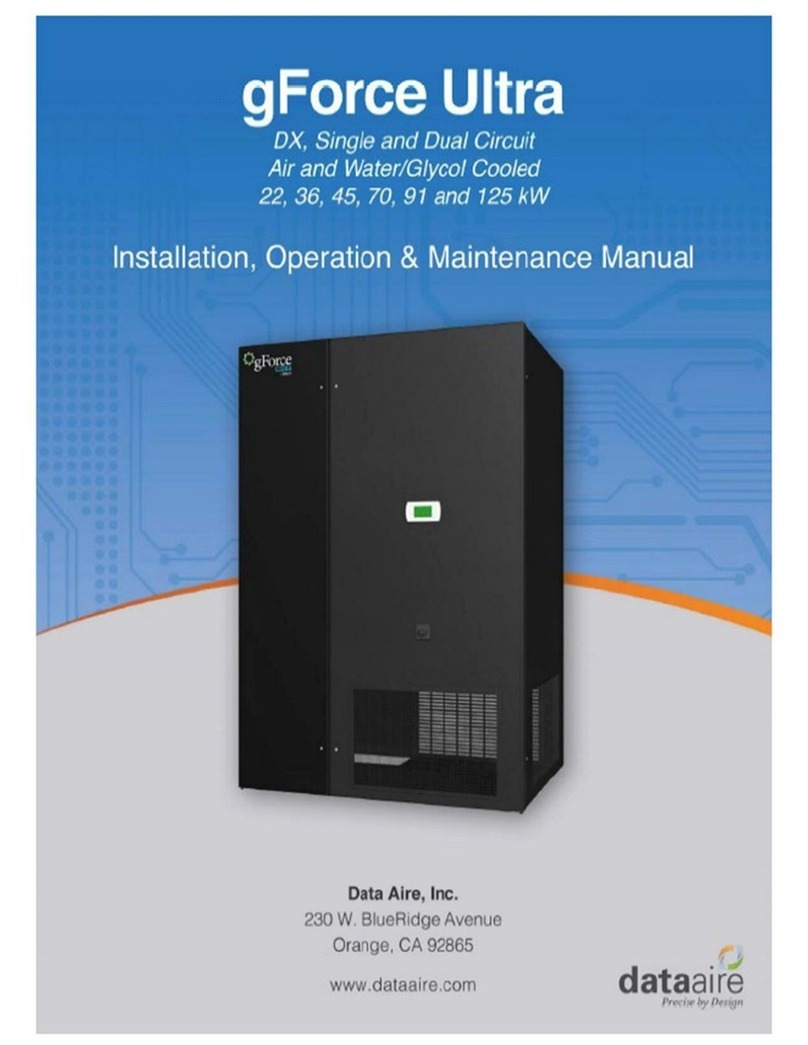
Data Aire
Data Aire gForce Ultra Instruction manual
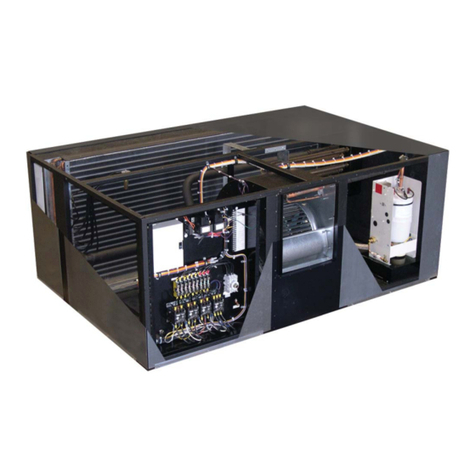
Data Aire
Data Aire LCS User manual

Data Aire
Data Aire gForce DX series User manual

Data Aire
Data Aire gForce GT series User manual
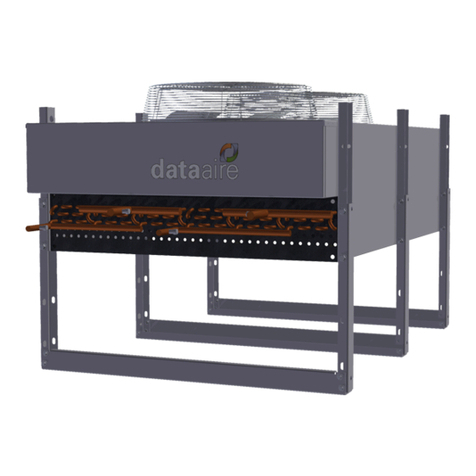
Data Aire
Data Aire DARC 03 Instruction manual

Data Aire
Data Aire gForce Ultra User manual

Data Aire
Data Aire gForce Ultra User manual

